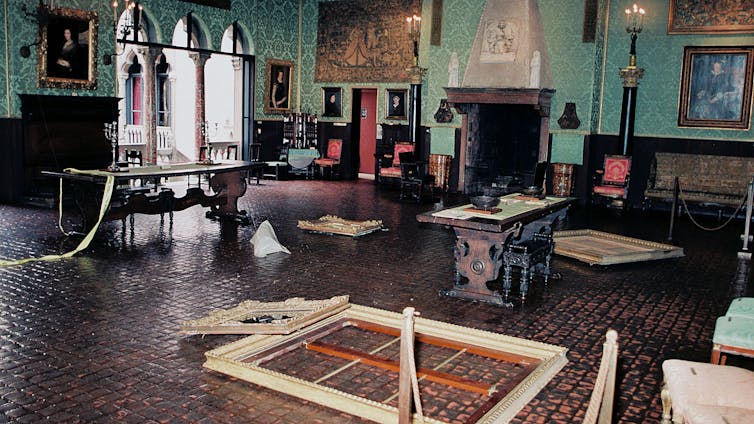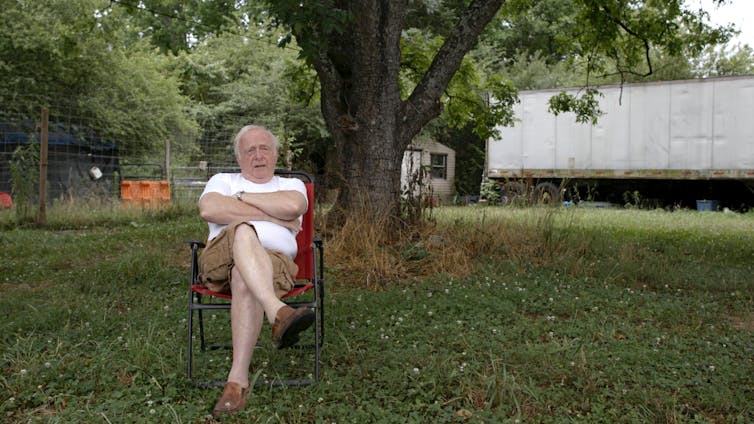Source: The Conversation (Au and NZ) – By Ted Snell, Honorary Professor, Edith Cowan University
Review: This is a Robbery: The World’s Biggest Art Heist, directed by Colin Barnicle.
After dreaming for many years of visiting Boston’s Isabella Stewart Gardner Museum, I was surprised by its dour presence when I finally arrived on its doorstep. The original building presented a rather austere face to the world, its stolid facade dwarfing an unobtrusive entrance. However, once inside, my every longed-for fantasy was realised.
The internal courtyard glowed with light sucked down from the glass ceiling. Palms and exotic ferns flourished in this hothouse environment. Visitors stood in awe — it looked like a Venetian palace, rooted like a tropical orchid in a frost-bitten landscape. In every room, masterpieces softly glowed within their gilt frames; antique furniture filled each nook, vases, and objects d’art on every surface. It was magical.
Then, on entering the Dutch gallery, the mood changed again. Hanging on the walls were empty frames, their vacant centres an aching tribute to the works that once resided there: Rembrandt’s Storm on the Sea of Galilee from 1633 and Vermeer’s The Concert painted soon after. Although still well-resourced with great works of art, the 1990 heist of 13 artworks had left a gaping hole in the Gardner’s collection.
Still unrecovered after 30 years, the US$200 million heist (at 1990 estimates, then equal to A$258 million) remains one of the most notorious art crimes of the century. Netflix’s four-part miniseries This is a Robbery digs deep into the myth and conjecture that surrounds this case. In the process, it provides insights into the criminal mind and dark machinations within the art world.Read more: What’s so special about the Mona Lisa?
Memories and mistakes
This is a rollicking good story, and director Colin Barnicle dives right in with fast editing and flashback clips that introduce us to the first of a huge cast of characters. We meet the museum director Anne Hawley, only six months into the role when the robbery occurred. We hear from the guards and police officers involved and local reporters who covered the news.
There are clues this might have been an inside job: the thieves spent 81 minutes in the gallery cutting paintings from their frames, unframing a tiny Rembrandt etching and unscrewing a finial from a Napoleonic banner.

The careful exposition of the details of the crime in contrast to the rough handling of the artworks makes for engrossing television.
“It was incomprehensible to me that even if they were wanting to steal art that you would treat it that way,” explains Hawley. Footage pans again and again over the detritus of the thieves’ actions strewn across the gallery floor.
As the series progresses, we hear from security consultant Steve Keller about the museum’s poor protocols plus earlier botched robberies and attempts to vandalise the building.
The museum’s vulnerability was well known. Its poor state of repair also put the valuable artworks held within its walls at risk and the extent to which the place was woefully ill-prepared for the St Patrick’s day break-in is laid bare in the documentary.
Bad company
On top of these security lapses, we meet an entertaining cast of crooks and hoodlums. Like the outrageous Myles Connor Jnr, who once walked out of the nearby Boston Museum of Fine Arts with a Rembrandt under his arm.
Then there are the colourful members of the Italian and Irish Mafias, stirring spaghetti sauce and wearing wires. Woven into the latter narrative is an exploration of the mechanics of large-scale art burglaries, used as collateral to underwrite drug sales and fund arms purchases for the IRA.
This roll call of crooks and dangerous criminals continues to expand and branch off over the four episodes until we begin to lose sight of the lost Rembrandts, Vermeers, Manets, and works by Degas.
Barnicle enthralls us with the daring escapades of central casting type crims including Louis Royce from the Rossetti Gang, Bobby Donati, Bobby Guarente, David Turner, Anthony Romano, Carmelo Merlino, and Robert Gentile.

Indeed as the plot thickens, the theft of the paintings and their ultimate fate sneaks off stage right. The viewer may feel like they are watching an episode of The Sopranos, interspersed with announcements by the Gardner Museum they are offering a reward of first $1 million, then $2 million, then $5 million and finally $10 million for the return of priceless artworks.
In a sense, the series functions as a big budget appeal for information from the public — a kind of art theft episode of Crimestoppers.

Read more: Trial over Picasso’s ‘gift’ to handyman and the murky world of art crime
No happy ending … yet
Finally, as we near the end of our three-and-a half-hour odyssey into this mystery, the focus shifts back to the Gardner Museum and the deep sense of loss that still beguiles the main protagonists.
Each has a suggestion of where the 13 artworks might be and who took them.
“When Robert Gentile dies, something will shake loose … someone will come forward”, a reporter says he’s been told.
The works might be in Dublin, Australia, Saudi Arabia or France others speculate. But as Robert Fisher, former Assistant US Attorney, intones as the camera pans up to the empty frame that previously held Rembrandt’s Storm on the Sea of Galilee, “Until you have the paintings, it’s all still just a theory”.
Although it meanders through true crime anecdotes at times, this is a great tale well told and definitely worth the investment.

This is a Robbery: The World’s Biggest Art Heist is streaming on Netflix.
– ref. Grand theft art world: Netflix probe into history’s biggest gallery heist is a rollicking story of lapses and loss – https://theconversation.com/grand-theft-art-world-netflix-probe-into-historys-biggest-gallery-heist-is-a-rollicking-story-of-lapses-and-loss-159054







